The season for the Wye and Usk opened on 3rd March in cold, dry weather. The Wye was running high and reasonably clear, coming down very slowly, while I would have described the Usk as already in perfect condition for early spring trout fishing. For most of us however, trapped in lock-down as we were, there was nothing to be done about any of it, but watch and wait for permission to travel. A few reports did begin to come in from anglers fishing their local waters. On opening day AB had seven trout to 14 inch from the lower Usk at Chainbridge, while Nathan Jubb apparently had a 10 pounds salmon on a flying C from the Wye at Whitney Court. On the 7th DR took four trout from the Usk at Old Clytha. Apparently two of these were taken during a March brown hatch lasting for 15 minutes at 3 in the afternoon, and he was using a large Deer Hair Emerger pattern. I have tried a few different patterns for newly emerged March browns over the years, but the DHE with its prominent impression of the diagonal wing works as often as not. Well done for what sounds like a classic piece of early spring Usk fishing. On the 8th Richard Parkin, new gillie on the Wye’s Golden Mile, had a 9 pounds salmon on fly from the Boat Pool. On the 10th in heavy rain, the third fish was also caught by a gillie, Glynn Cawte, who took a 22.5 pounds springer at Luggsmouth with a black and yellow flying C. This was the first three sea-winter fish of the year. Then on the 11th, just before the next rise, Lower Bigsweir reported a 40 inch cock fish, also on a Flying C, from the Cockpit. My own very limited local fishing effort during opening week was to spin some deep pools at Ross on Wye, until the level dropped and the fly rod and fast sink tip came out of the tube on a couple of mornings. I had nothing to show for it but several large trout, which actually looked to be in fine condition despite the winter of floods.
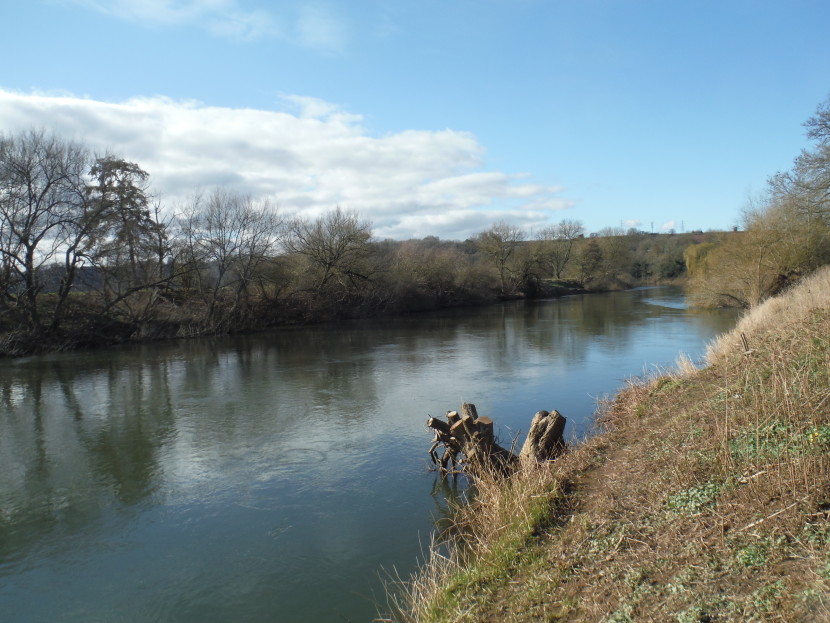 Lower Wye in March
Lower Wye in March 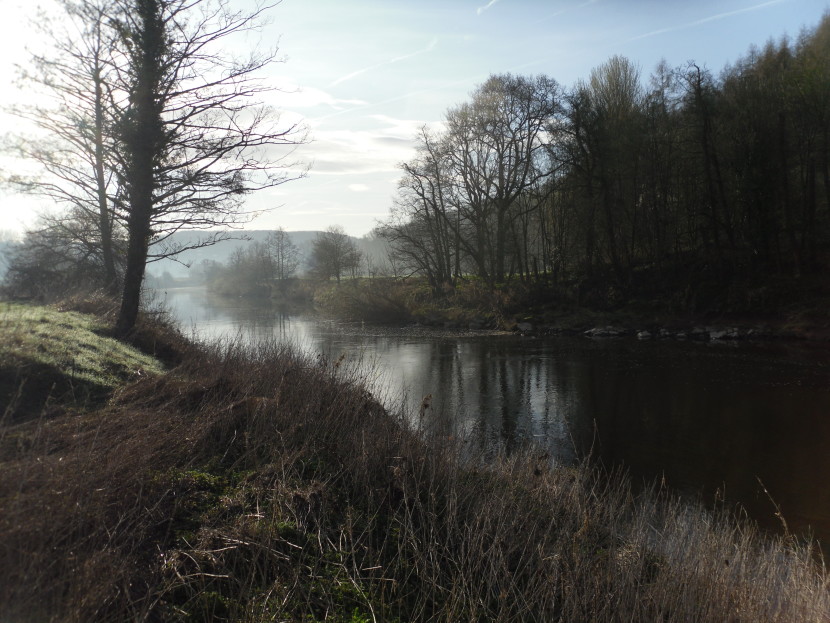 Lower Wye's Vanstone Pool in early spring
Lower Wye's Vanstone Pool in early spring 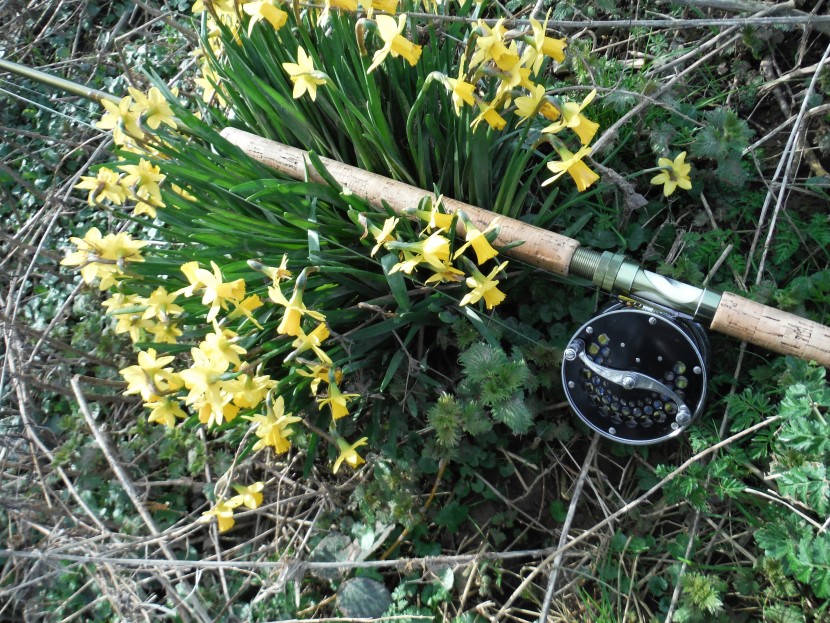 On the local Wye again in spring.
On the local Wye again in spring. 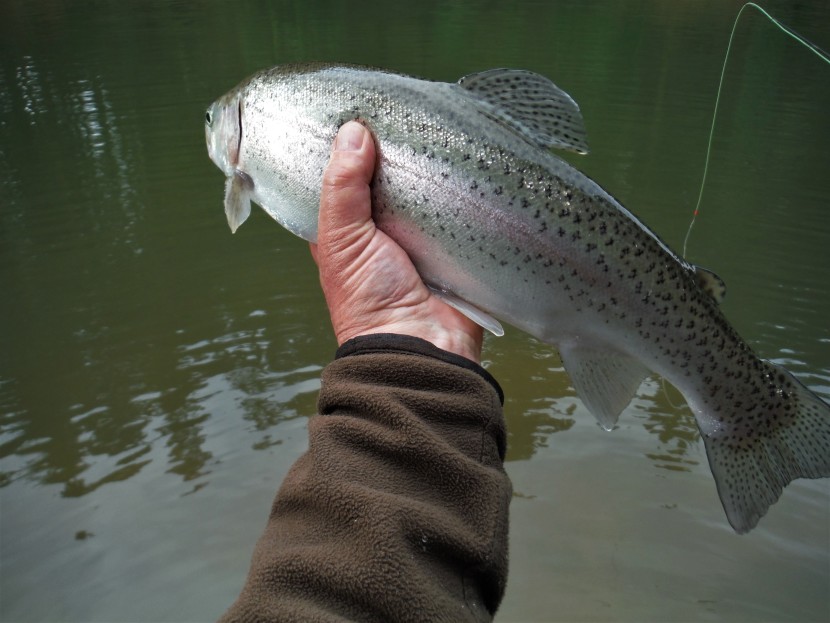 Rainbow on buzzers
Rainbow on buzzers A halt of several days followed with all the rivers in flood. I went back to fishing forest pools for rainbows, this time with a team of heavy buzzers. Provided you don’t try to retrieve these flies at any kind of pace, but merely let them fall down the water column before inching them along very, very slowly, it is amazing how firmly and confidently spring rainbows will take them! Fish them under an indicator if you must, but using more conventional straight line nymphing with a floating line there was none of that diffident pecking and tail tweaking by rainbows experienced by the lure fishers.
On the 12th March Welsh First Minister Mark Drakeford appeared on our televisions with his long awaited announcement on the route out of lock-down for the principality. Clearly the man is in no kind of hurry and he seems very determined to keep the English at bay for as long as possible, almost as determined as he is to keep the Welsh out of pubs. As far as freedom of movement and exercise are concerned, Welsh citizens who had been allowed to leave home for exercise only on foot, from the 13th could now drive up to 5 miles. By the 27th he hoped that Welsh citizens would be able to travel further within the principality and even stay away from home during Easter. However the FM warned all providers of overnight staying in Wales not to take bookings from citizens of England. He followed that up with the strange remark that “If it won’t be safe to stay overnight in England, then obviously it would not be safe for people to travel into Wales.” This somehow seemed to put the blame onto Westminster and he added that the Wales police had been briefed accordingly. I know that I am not a Welsh voter but I would love Mr Drakeford to explain to me why the fact that I don’t have overnight staying options in whichever country means that I can’t drive 5 miles into Wales, or for that matter 50 miles into Wales, for a few hours of open air fishing in quiet countryside before going home? I am happy to spend the night in my own bed. At a time when we have progressed to full legal freedom of movement in both nations, is nobody paying any attention to those who live and now wish to move around and (what is more) spend their money in the border areas? Now that I think of it, I don’t believe that at any time during the pandemic has Westminster made any statement restricting Welsh citizens from travelling in the direction of England. If you get the impression from what is written above that I am finding the Welsh situation slightly irritating, you would be right. I am still having to tell English clients who want to fish for a day in Wales to be patient and wait now for 12th April.
Severn tributaries opened on the 18th, which made it possible for me to vary my own daily fare a little by fishing my local Forest of Dean brooks, which are looking distinctly battered after the early spring storms. Cannop in particular has many newly fallen trees across the channel. It wasn’t quite warm enough for the dry fly yet, but all the sights and sounds of spring were around me: the first leaves showing green, woodpeckers hammering in the distance, dippers nest-building and mallard squabbling over the inevitable menages a trois which they seem to form at this time of the year. I was doing nothing more complicated than casting a single nymph upstream and watching the leader for takes. There is a curiosity about these streams which use of the nymph occasionally brings to view. Every now and again the hook tapping along the bottom catches up in a slightly unusual lump of material which will swing to the surface. Very uneven and porous, it is strangely heavy for its size and if you hold it against your net release device you will find it is magnetic. People mistake them for meteorite fragments. It is in fact furnace slag and it is spread throughout all these streams mixed in with the gravel. You also find plenty of it in the bed of the main Wye at Symonds Yat. Very often pulling a magnet through the coarse black sands on marginal beaches will pick up little droplets from the once molten metal – a reminder that men have been smelting iron in this forest for more than two millennia.
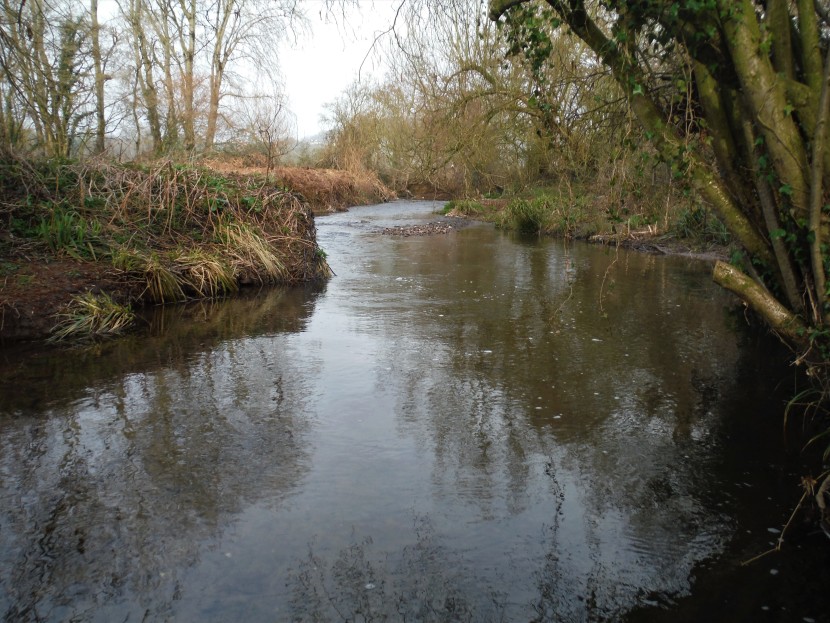 Opening day on Bideford Brook
Opening day on Bideford Brook 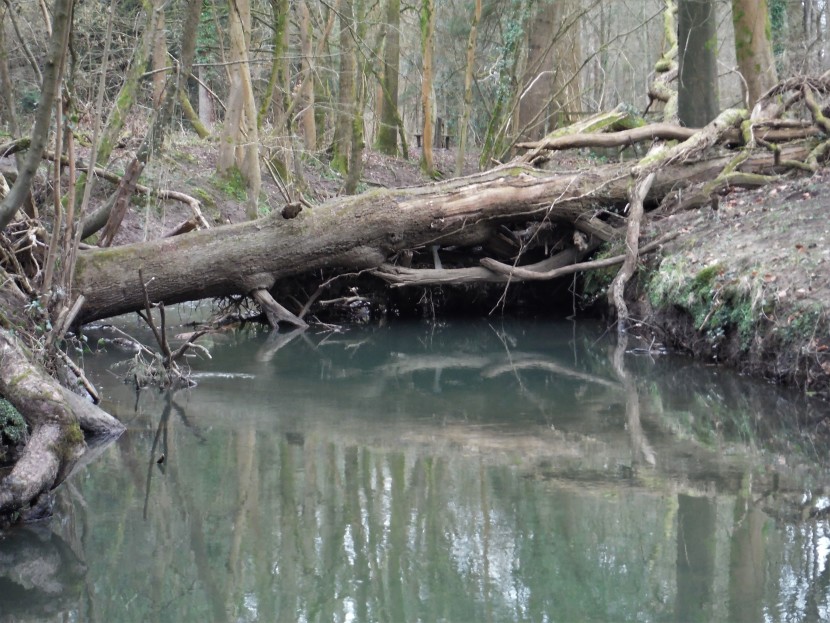 Storm damage
Storm damage 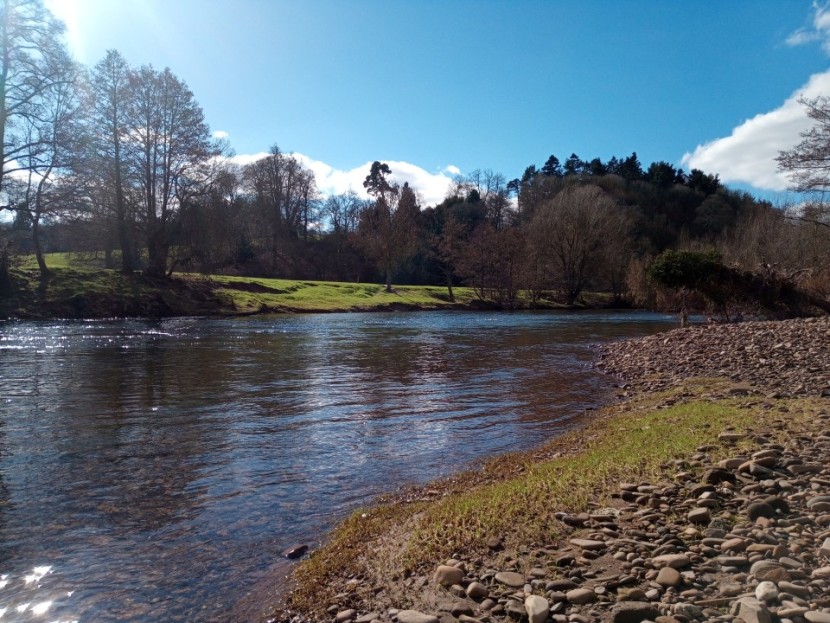 Old Clytha - DR from Llanarth
Old Clytha - DR from Llanarth Meanwhile the Wye and Usk were dropping back steadily after the last flood. The Wye in particular looked in good condition for salmon and there was a certain amount of local fishing effort put in, but days went past without news of another springer being caught. Some were talking of the Wye spring run now being, not so much reduced, but collapsed. Then on the 21st came news of a 24 pounder from Hatton Hole on Holme Lacey, followed by an 18 pounder on the fly by Dave Palmer who was fishing the Golden Mile’s Boat Pool. On the 25th Joe Cobley down at Wyesham got a 21 pounder, and the following day there was an 18 pounds fish from the same beat. Both these were on the Flying C spinner. Although the top of the river was now too low to expect much, some hopes were expressed that spring tides at the end of the month might bring in some more springers to the lower river. Whatever happens now, they have certainly been few and far between this year. I try use my imagination as I work through the pools, but this early fishing can sometimes be a plodding kind of affair. While casting a heavy salmon tube on the Ross section one sunny morning I suddenly found myself in the middle of a nice little grannom hatch, which only made me think how pleasant it would be to be fishing the Usk with a trout rod instead. On the 27th Chad MacDonald reported a 15.5 pounds spring salmon from the Usk, the first on that river, and Whitehouse on the Wye had a 15 pounder. A couple of two sea winter fish with the spinner were also reported, from the Vanstone at Goodrich Court and from Upper Bigsweir. There were also a few accounts from the lower river of on and off contacts, fish turned over with a couple of kicks and a flash of silver. With barbless hooks, I am not unduly surprised. JH from Usk fished the Edw at Hergest and caught 13 trout with a nymph. Rather more rain in the hills than had been forecast on the 28th produced a rise of about a foot to the upper parts of both rivers which duly rippled down to the lower ends.
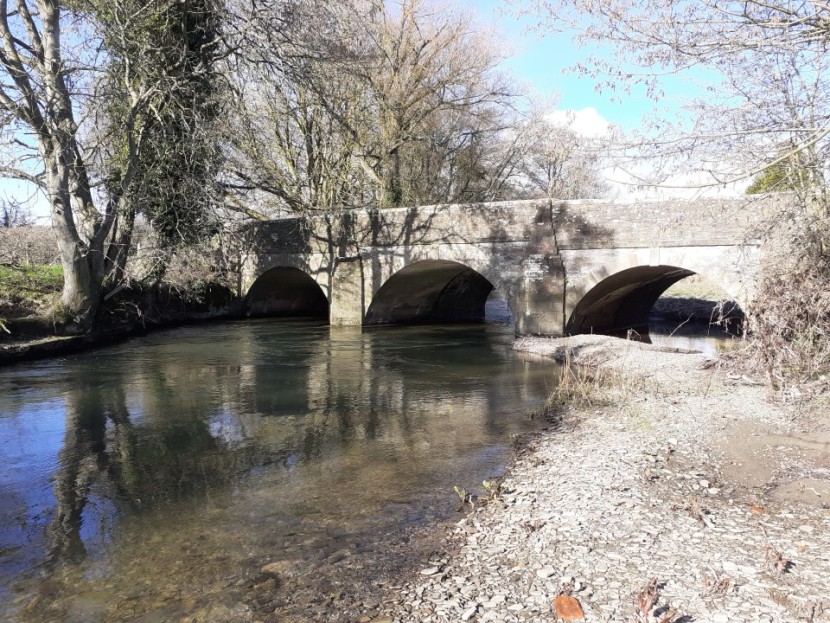 Court of Noke - JA from Leominster
Court of Noke - JA from Leominster 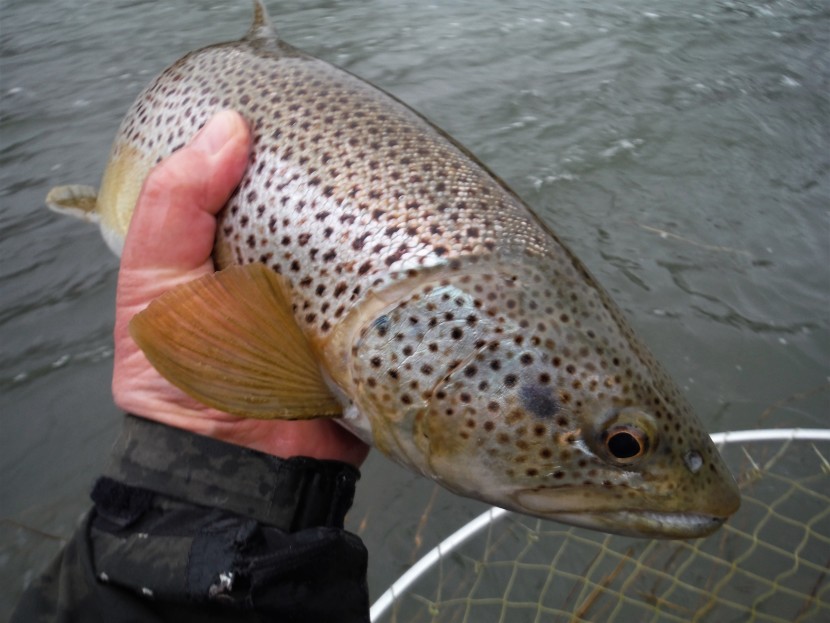 Lower Wye trout
Lower Wye trout 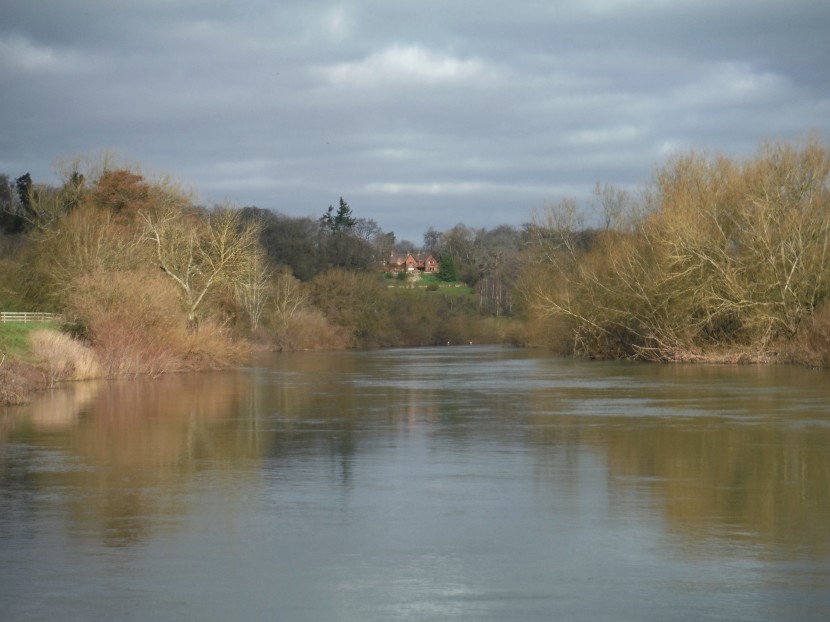 Wye at Benhall
Wye at Benhall Fast forward a bit to July and August. While most of us wait for restrictions to be lifted and to go fishing, we can at least think forward to warmer days and nights when coronavirus may have retreated further. In short, I have been thinking that even if our beloved spring fishing has been interrupted for a second year, maybe during the summer we can have some nice sea trout fishing in Wales as some kind of compensation. Now do you remember that a few years ago there was a range of lines on the market called Sewinmeister? These were 8 weights with short and aggressive front tapers, just the right thing for sea trout at night I would imagine, although I never got to try one out. The name amused me at the time: a sort of curious mix of Welsh and German, but somehow very appropriate for everything we imagine about an expert, a master of this rather arcane branch of fly fishing.
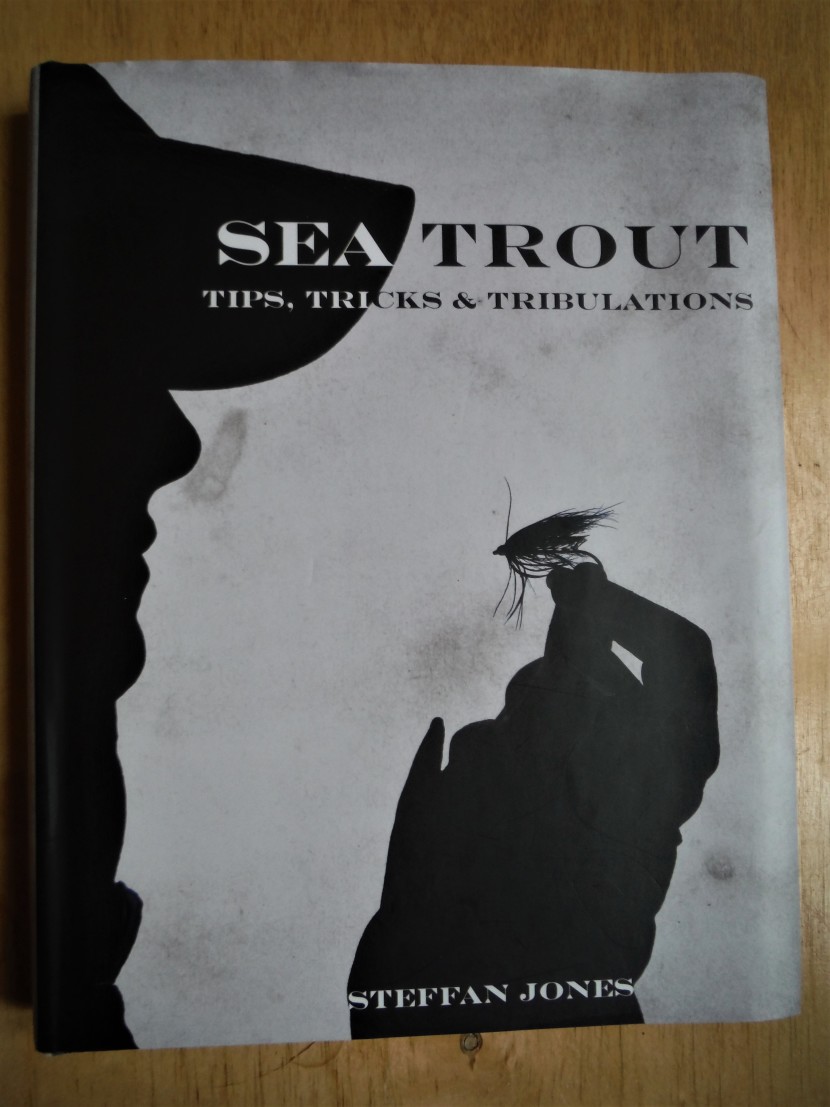 Steffan Jones on sea trout
Steffan Jones on sea trout Of course there have always been those who are regarded as masters of the craft. Hugh Falkus has been described as “the father of modern sea trout fishing” and certainly for years the memory of the man and his book has been treated with reverence verging on awe. For those who, like me, used to read the Falkus book anew at the start of every summer season, there was at one time almost a feeling that the last word on the subject had been written. However, I don’t think we would say as much today, when new ideas are abroad and even the great man’s pronouncements are sometimes challenged. Meanwhile I know of a few anglers who by their proven results can truly be called modern masters of the craft, and yet some of these play their cards quite close to their chest. There is the joke about the Welsh sewin angler, who only in his will was prepared to reveal, posthumously and to his closest friends, protected within a sealed envelope, his list of favourite sea trout lies. Others would tell you what they could, but do not possess particular communication skills.
One modern angler who does have the fishing skills and means to communicate them is Steffan Jones of SW Wales, who both teaches and writes. For quite some time now, Steffan has been the man of the moment. This winter I kept a promise to myself and acquired his book of advice: Sea Trout: Tips, Tricks and Tribulations. It certainly gave me something to think about during lockdown, ready to plan for those warmer nights of high summer. Steffan was brought up in that gentle pastoral country between the Towy and Teifi and, slightly unusually, seems to have fallen in love with sea trout fishing as a boy without ever having read the classic works on the subject. No doubt in early days he had some help from older anglers, but most of his conclusions have been derived from personal experiment rather than accepted wisdom handed down from angling literature. Accordingly, the book describes his own way of doing things.
He begins with some general points, including “what makes a good sea trout river,” holding to the modern view that brown trout opt for sea migration in order to compensate for poor river feeding. It follows that a rich river may not have many sea trout. Why are sea trout caught in the dark and not salmon (despite some instances related by Falkus)? Surely because of their different feeding habits in the sea: deep water salmon are daytime feeders while the hunting of sea trout in coastal waters begins in darkness. Do sea trout feed in the river? Smaller ones sometimes do. Incidentally there is not much cooking in this book; Steffan himself rarely takes a fish for the table beyond the occasional shoalie. I will list the tactical points he makes under short headings.
Don’t fish too many beats. Others have told me this. Rather than dashing from river to river, wherever you have heard of the latest good catch, concentrate on a few beats and learn them really well. It takes years to get a deep knowledge of even one beat. Steffan makes the point that there are places on the Teifi and Towy which even as a professional fisherman he hardly knows to this day.
Sea trout are the same wherever you find them. Despite the remarks above, Steffan has fished around the world, including in Argentina, and claims he finds that the sea trout actually behave in much the same way in different rivers. I haven’t been so lucky and only know a few Welsh rivers, so can’t comment, but it is reassuring information.
Reconnaissance. He believes in lots of time spent on daytime reconnaissance, particularly in the early part of the season. At night, if other anglers are not around to be annoyed, he will actually shine a white light into the pools to see what is there. I have been known to do that just before leaving for home, but not systematically. Sea trout picked out with the torch generally pay no attention for a minute or two, before eventually gliding away.
Holding pools and transition water. These can easily be defined when the water level is low. He has much to say about fishing these different areas of the river, according to conditions and the time of the night. On reflection, when fishing as much as a mile of our little Loughor in an evening, we tend to concentrate more on the transition water, such as the runs at the heads of pools, but more importantly the tails. An evening on the Towy involves both, perhaps beginning with the fast water at the head and finishing up by concentrating on the tail. Steffan spends a lot of time on the slack holding water which would be regarded as “dead” by the brown trout and salmon angler.
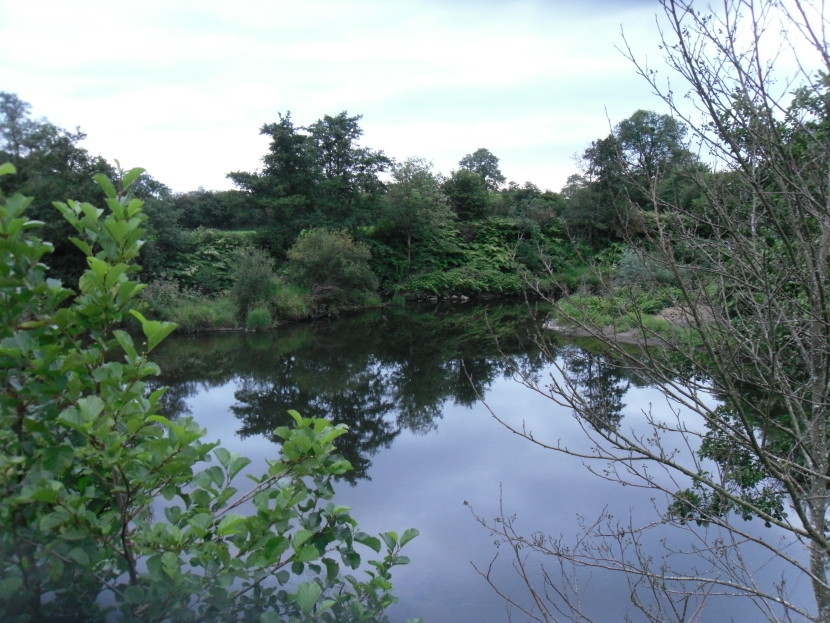 Loughor, holding pool
Loughor, holding pool 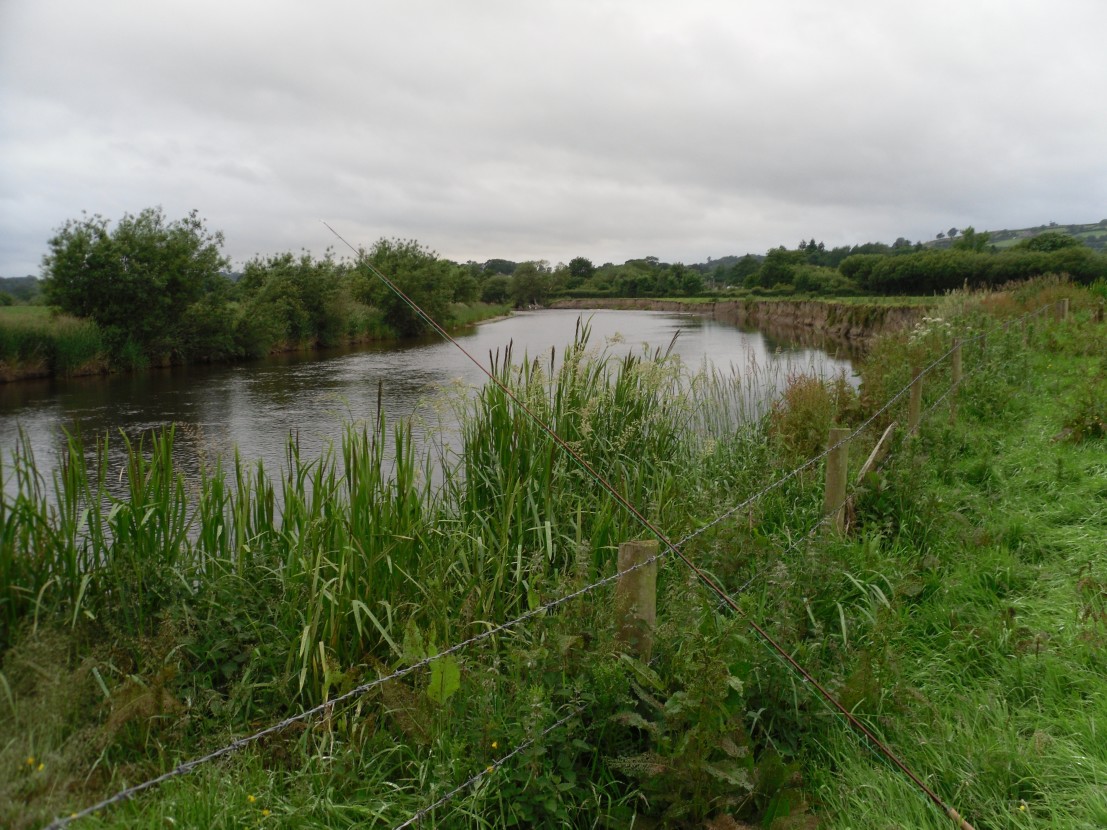 Middle Towy in daylight
Middle Towy in daylight 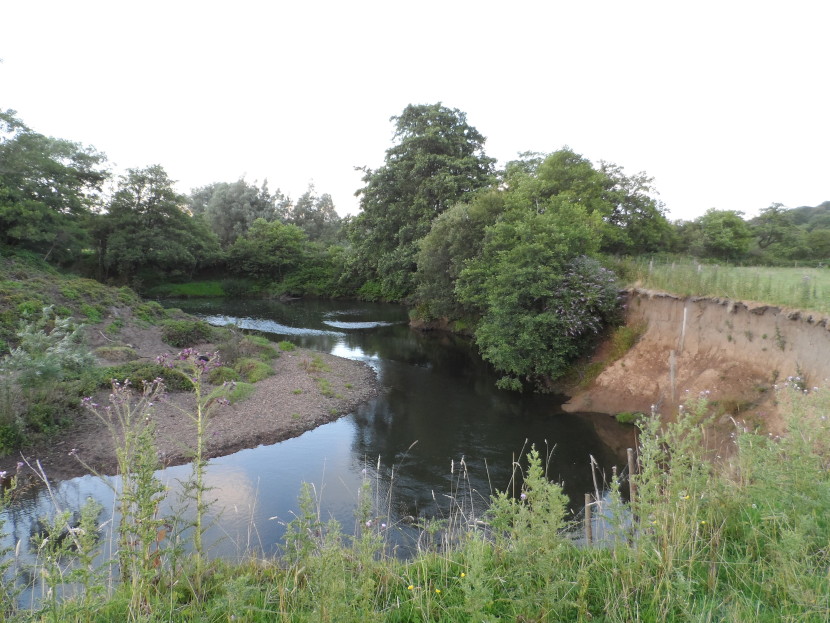 The Loughor, haunt of huge sewin
The Loughor, haunt of huge sewin 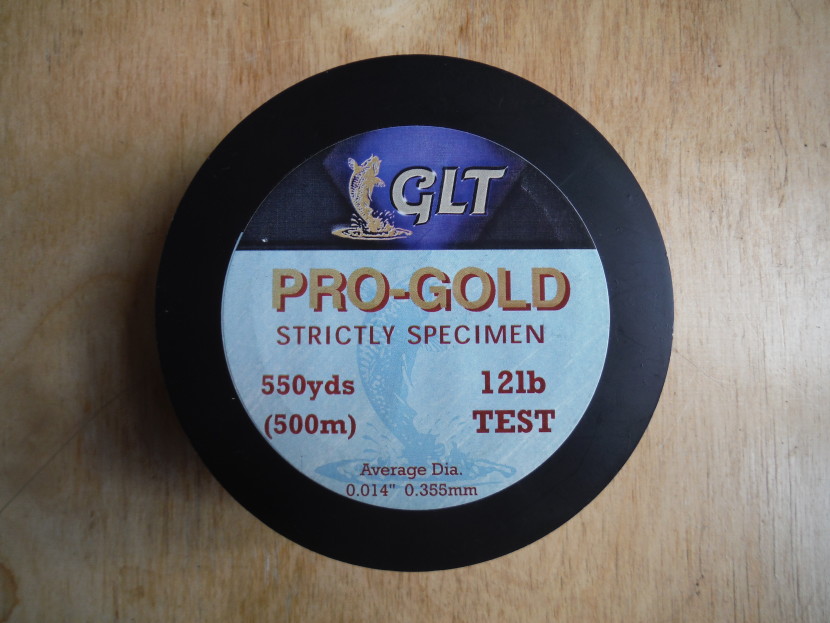 12 pounds test heavy leader material
12 pounds test heavy leader material The most important thing about the fly is not its pattern but its size/length. This is slightly surprising given the number of patterns which have accompanied Steffan’s magazine articles over the years. I guess we can blame an editor’s demands for that. Most of his flies are black and silver, sometimes with red varnish trigger points or jungle cock added. Some of them are quite large. The fly size should match the light. He fishes flies of an inch or so if the water is clear and light levels high, but much larger to obtain the silhouette he feel is needed if the fish’s vision is impeded by clouded water and/or low light levels. He changes flies a lot during the night as light levels vary. This provoked some thought in me, because the anglers I know tend to choose their fly more by the river they are fishing, using relatively small black, blue and silver tubes for the Loughor, but, even in the same light and water colour conditions, larger flies incorporating some red for the Towy.
Casting angles and speed of retrieve. He has much to impart on these two subjects, mostly in an attempt to achieve the right speed of the fly. He is very much in line with the view of Falkus, casting a long line downstream and permitting a slow retrieve if the water is really fast, but casting square and probably retrieving faster if the current is slow. Generally he likes a steady retrieve rather than a series of strips for sea trout, often using a brisk figure of eight or even a roly-poly retrieve. He advises never slow down on a following fish.
Time to start? Calendars and fancy watches are not much help, except perhaps to tell you when to plan your trip or set out for the river. You should certainly be on the bank and getting ready by 1 hour after sunset, but the reality is that the difference between a bright clear evening and one with low cloud can affect light levels and your starting time by as much as an hour. He gives the advice to wait until the colour green in your surroundings has faded into monochrome, and then give it another 15 minutes. Then start fishing with small flies on the transition water at the head to give a margin of error, then as darkness thickens the main body of the pool which should hold fish will be addressed, probably with larger flies, and finally the tail. The pool tail is the cream, which might hold resident fish which have dropped back, plus some new arrivals.
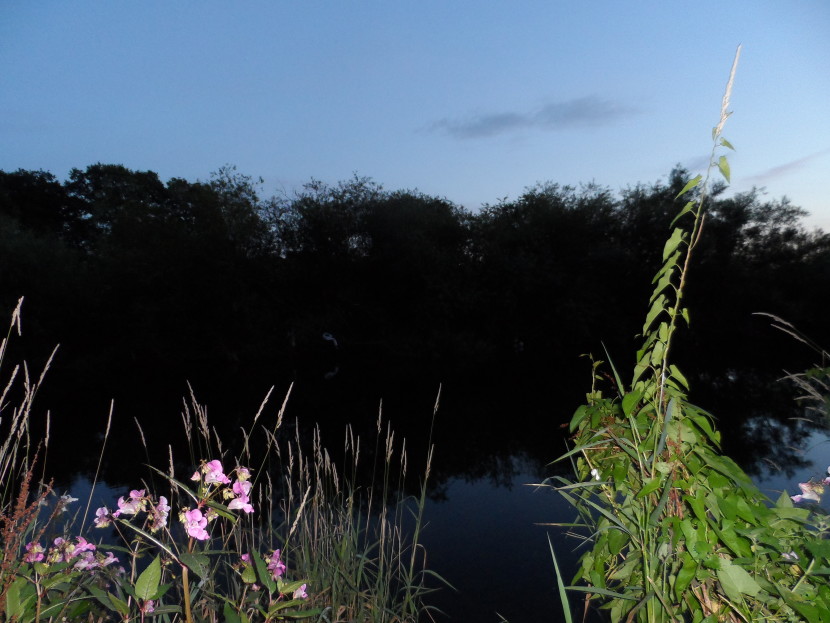 Soon be dark enough.
Soon be dark enough. 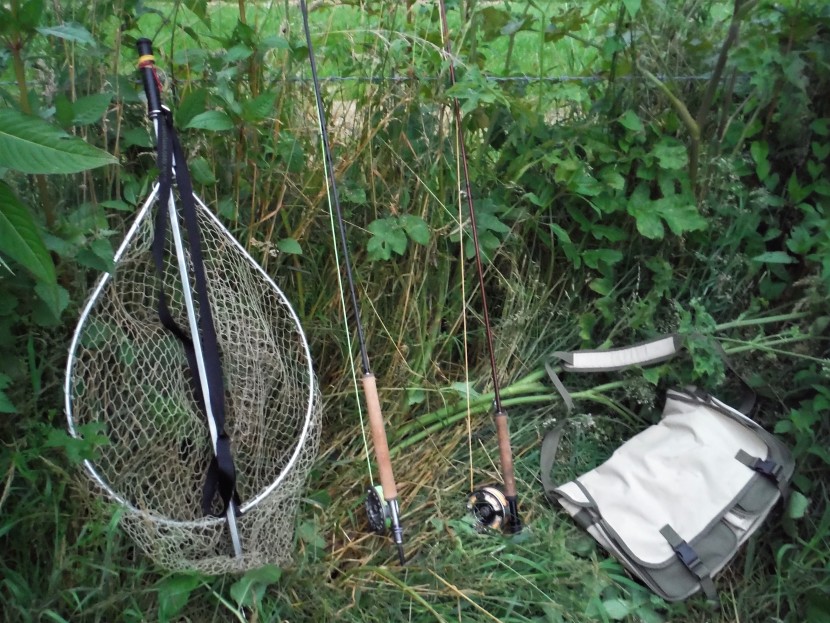 Towy, waiting for dark
Towy, waiting for dark 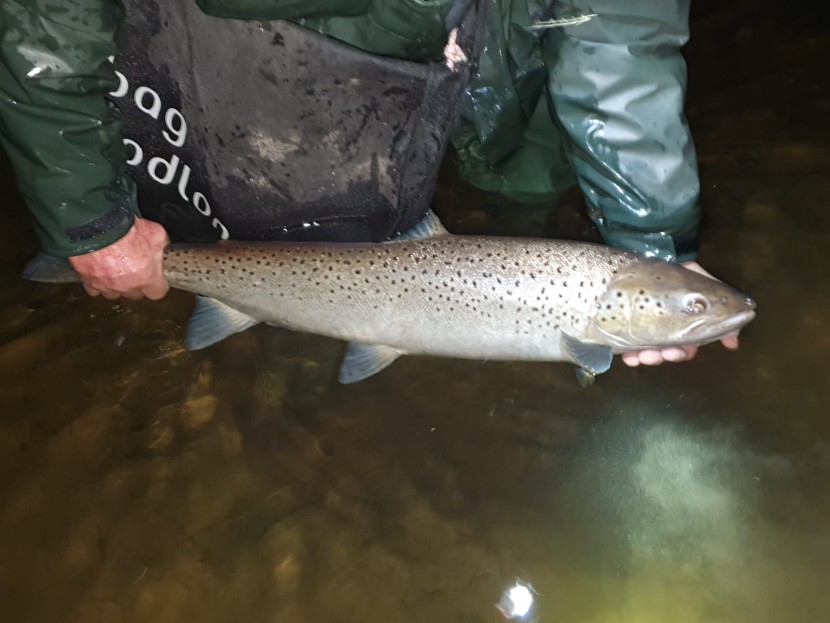 Sewin for Lyn Williams
Sewin for Lyn Williams Move fast the first time down. Steffan recommends two steps between casts…which, given that he will be experimenting with angles and retrieval rates at many of the stances, strikes me as brisk, but not so very fast.
Rod angle? Almost always low with the rod pointing down the line. The exception is that the rod tip might be lifted a foot so during the last few yards of the retrieve, in case of a smash take by a following fish.
Retrieve? Again, this to Steffan is almost the most important point. It should be adjusted to the speed of the current as the fly moves from fast to slack water, with the idea of keeping the fly constantly and steadily moving. He uses a figure of eight retrieve most of the time, sometimes a fast figure of eight or even a roly-poly with the rod tucked under his arm. He feels that most sewin anglers tend to retrieve too slowly.
If you receive a pull, try again. No reference is given here to backing up a few yards or waiting for a couple of minutes. If subsequent casts produce nothing, make a mental note of the spot for special attention next time down and move on.
Strike? Always strike with sea trout, at the least movement of the line, whether striking up or sideways. He doesn’t mention strip-striking by pulling on the line. The exception (see below) is with the surface lure.
Second time through the pool. This time the transition water at the head is usually skipped, but a lot of attention is given to any place where a pull was experienced during the first pass.
Third time through. Now it’s probably well after midnight and time for the surface lure. Steffan claims that it doesn’t work well during the early season or early evening. On late season trips recently, however, I have taken to using the surface lure from the start and done quite well. Admittedly these were very dark cloudy nights. Steffan agrees and at the end of the section mentions that he himself often fishes with the surface lure from the beginning during August and September: “…absolutely lethal.” He suggests that the surface lure is only fished over slow water and recommends fishing it well under the trees to the far bank. The cast can be made in gaps between the trees, after which the lure can be drifted well under the branches before the line tightens and it begins to accelerate. This works better with a surface lure than a sunken one which tends to hit the bottom before swinging under the branches.
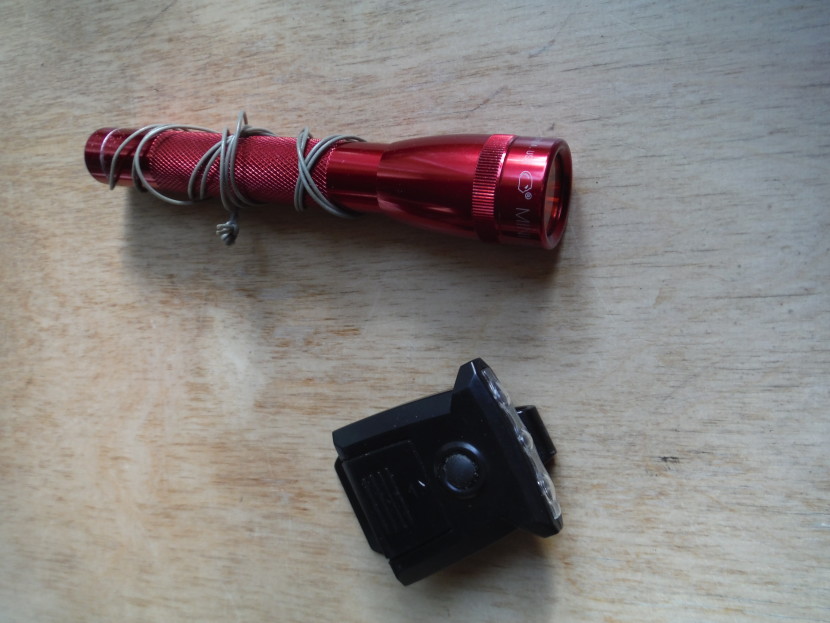 Torches for the night
Torches for the night 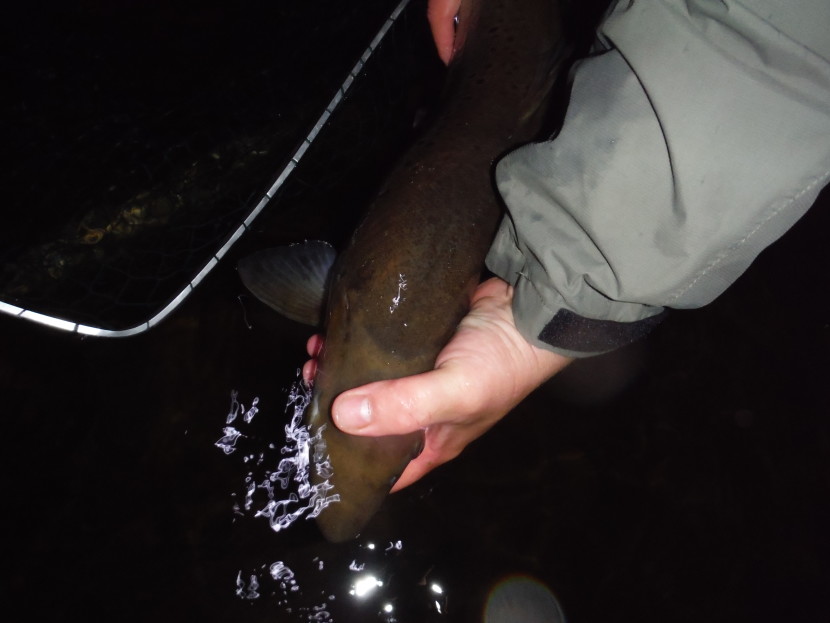 Back to the river
Back to the river 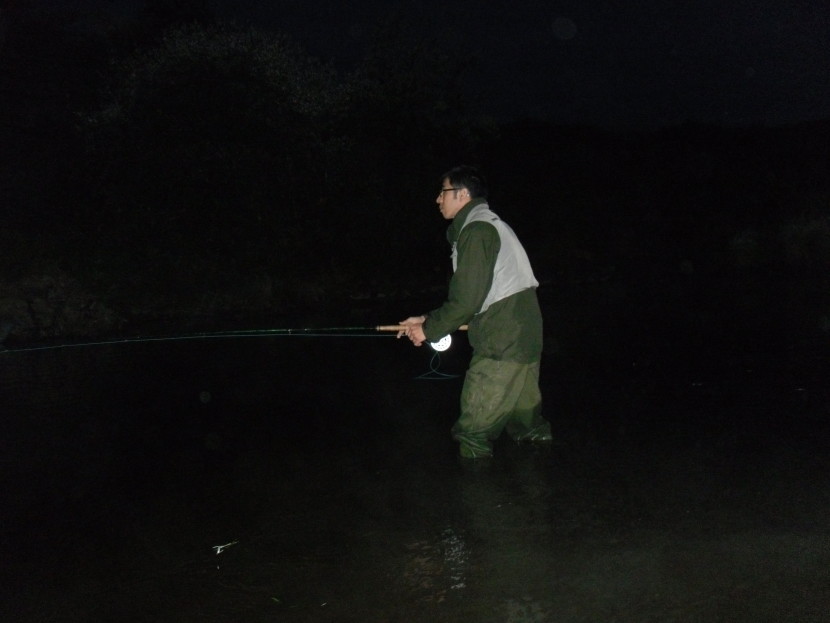 Waiting for the take on the Loughor
Waiting for the take on the Loughor 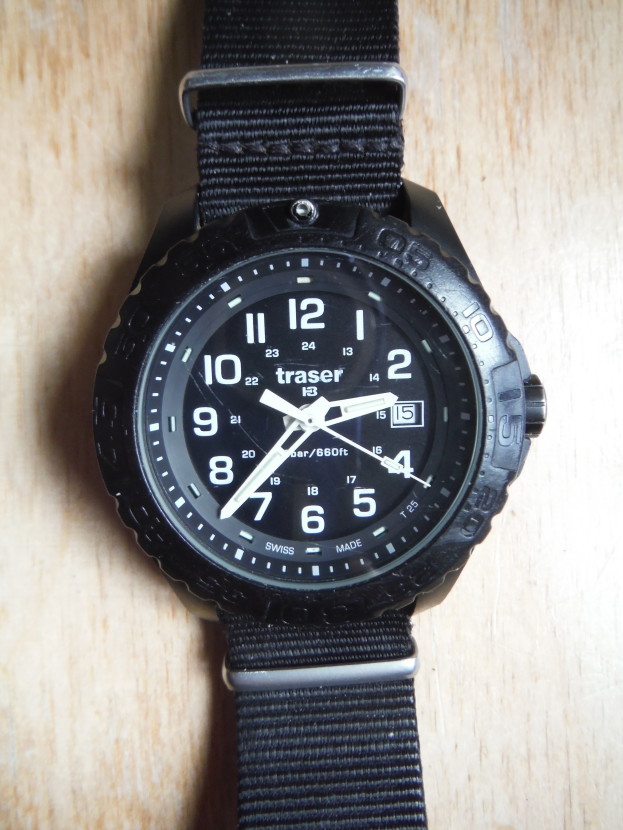 No pressure, but water-proof and the hands are luminous
No pressure, but water-proof and the hands are luminous Barometric Pressure. He does have one of those famous watches to measure air pressure and recommends the Times Expedition WS4 or the Casio Pro-Trek. Such names as Reg Righyni and Andrew Bett have trod the barometric pressure path before him. Steffan argues that sudden drops in pressure (heralding a weather front and rain) are likely to start the fish running. At such times they will change their position in the pool and may become poor takers. I can think of a couple of occasions when I have had the opposite experience, possibly because new fish had just arrived in the pool? Generally Steffan prefers a steady barometer and settled fish.
Mist. Steffan uses the Welsh word, tarth. We don’t seem to have suffered from this so much in recent seasons, but I have always found it fatal to success. Steffan believes the problem is simply that thick mist over the surface blocks the light and obscures the fish’s sight of the fly’s silhouette. He suggests using a big fly fished very slowly, perhaps with the addition of luminescent materials and chemical lights. (John Graham, on the other hand, insists that provided the angler persists, sooner or later in the night the mist will lift and fish come onto the take. To stay on through the small hours in a cold mist is certainly an act of faith).
Night fishing in coloured water. Generally it’s better to fish by day when there are visibility problems. However, if you must do it, Steffan suggests big, bulky patterns to be fished over water of 4 feet depth or less. A sea trout on the bottom 8 feet down is unlikely to see a fly through murky water unless you are lucky enough to present it right in front of its nose.
More on fly choice. Steffan doesn’t believe in the “half-time theory,” by which larger flies are used after midnight. Instead he goes by light levels: the lighter the night, the smaller the fly, the darker the night, the larger the fly – and some of Steffan’s are very large. The fly must be big enough for the fish to see it and this goes for coloured water also. Fishing two flies gives him the chance to offer slightly different silhouettes, should he be uncertain. He also mentions (and I concur) that if brown trout are showing interest in the fly, then you have a good chance of sea trout also. If the brown trout can see it, so can the sewin. I would say the same about fishing for salmon by day.
More on casting angle and retrieve. The faster the current, the further downstream you cast. The slower the current, the more square you cast. Drift flies, particularly the surface lure, under trees before commencing a steady retrieve. Mend and throw down extra line after the cast in order to get the fly further under cover before the retrieve starts. Keep the rod tip down at the surface and concentrate as you hand-line with a brisk figure of eight. Keep the line running between fore finger and rod handle ready to lock up in case of a sudden wrench pulling out of your hand. Speed up the retrieve when coming into slack water to keep the fly moving in a life-like way. Stop-start stripping the line doesn’t work so well for sea trout, and in fact avoid changing the retrieval speed over one cast, but experiment if you like between different casts. Sea trout generally prefer flies moving quickly to flies moving slowly. If you are plagued with plucks on the line, try speeding up.
More on surface lures. Why do sea trout attack surface lures? Steffan discounts the theories about swimming mice, but he feels it may have something to do with sea trout in the sea attacking shoals of bait fish after which casualties are taken from below. I don’t know if I am convinced, and I keep remembering the water vole once found in the stomach of a 6 pounder by a friend of mine. Whatever the reason, sewin do attack a surface lure and for fishing it you need a warm, muggy night with cloud cover. Early in the season Steffan will have the surface lure on a second rod for use late in the evening. He uses a short-bellied fast loading line and a short thick leader to turn the big fly over. On designing lures, he likes a big single hook and uses a certain amount of buoyant foam as well as deer hair, which can get saturated over time. The lure should hang in the water tail down until it begins to swim. Surface lures often don’t work over deep water; if it’s cold, fish can be reluctant to rise over 6 feet from the river bed. He is thus more confident fishing the surface lure over 3.5 or 4 feet of water. Sometimes takes are relatively gentle, in which case he suggests delaying the strike until you actually feel the weight of the fish on the line. Do not strike merely at splashes heard. Given the nature of this fishing, most anglers will be fishing the surface lure unseen for most of the time, but Steffan suggests adding some “glow in the dark” material to the back of the fly and charging it up with a torch.
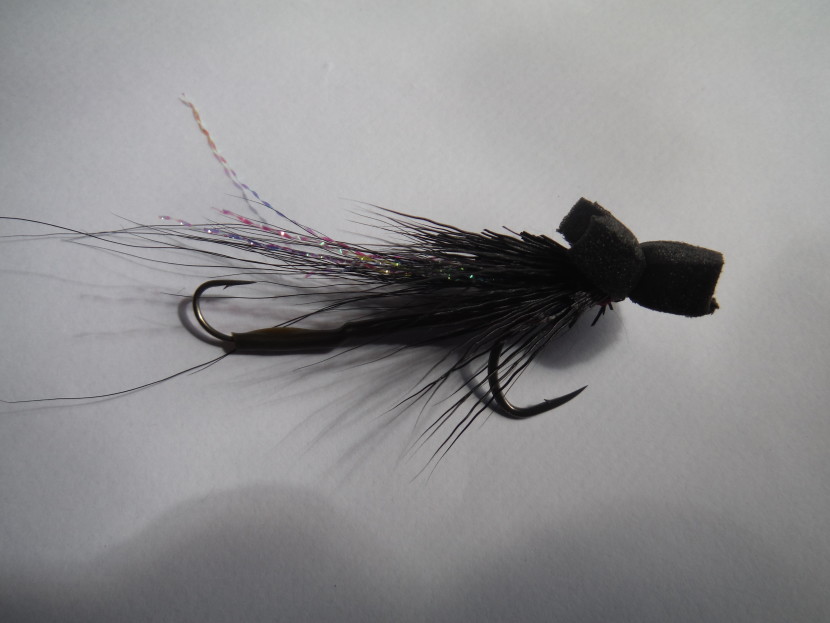 Surface Lure - Steffan Jones pattern
Surface Lure - Steffan Jones pattern 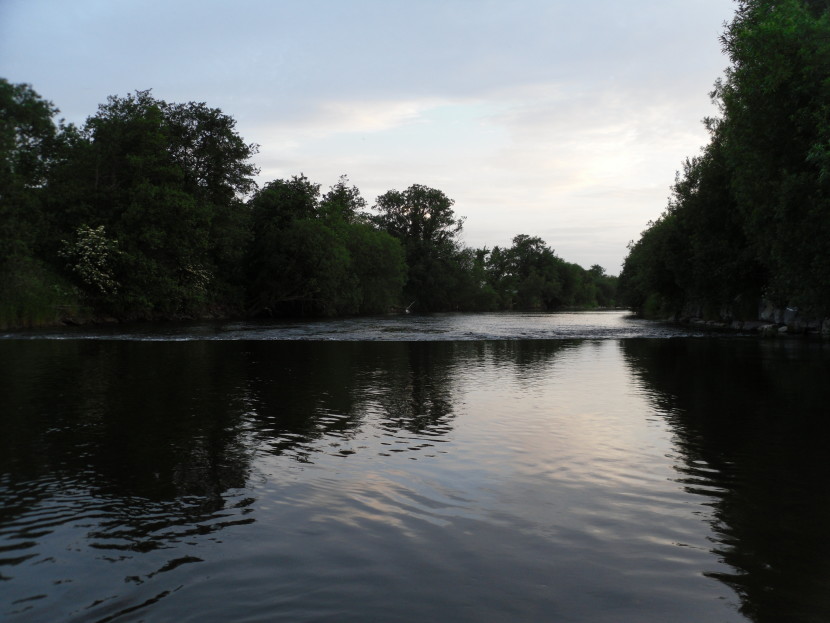 Towy weir, Llandeilo water
Towy weir, Llandeilo water Fishing stagnant water (holding pools). I don’t know if “stagnant” is the right word, but many anglers avoid dead water in wide pools on the basis that sea trout are rarely caught in them, even if they rest there. Steffan suggests that if it looks like a lake, fish it like a lake and he recommends using an intermediate line to fan-cast around from a vantage point in the shallows. He casts at close range at first, gradually lengthening line and varying his retrieve, taking care to skate the dropper at the surface for as long as possible before lifting off for a new cast. This sounds very like the “fishing round the clock” of Hugh Falkus. He also deals with the tricky matter of fishing back eddies during which 5 metres of line may be pulling one way and 5 metres the other (lift and drop the rod tip quickly if you can’t see which way the line is lying). This is a problem also addressed by Graeme Harris and Moc Morgan in Successful Sea Trout Angling. The Gutter Pool on the Loughor is a classic example. It isn’t an easy matter, but by casting and then walking down current it is sometimes possible to work your fly down far enough to be taken by a deep-lying fish which would not come up to the surface.
Artificial light. Steffan obviously has naturally good night vision and he takes steps to preserve it. He can make up his leader with a dropper and attach the flies to it using residual light and without resorting to a torch. He isn’t one of those paranoid about red or white torch light on the river though, arguing that sea trout have not proved to be bothered by permanent artificial illumination (by street lights for example), nor do they much mind fleeting lights seen nearby. It should be enough for an angler to turn his back on the river when changing his fly or sorting out a tangle.
Window of vision. This subject is more complicated than it seems. In theory, a trout lying on the bottom in 6 feet of water has a wide window of vision taking in a large area of the surface. But then, in cold water the same fish may be unwilling to rise far towards the surface to take a fly. Fish the fly deeper on a sinking line and the fish will have a smaller window of vision at the necessary depth. It may then miss the fly altogether. He also makes the point that in the case of coloured water the window of vision may become more and more blurred at the periphery.
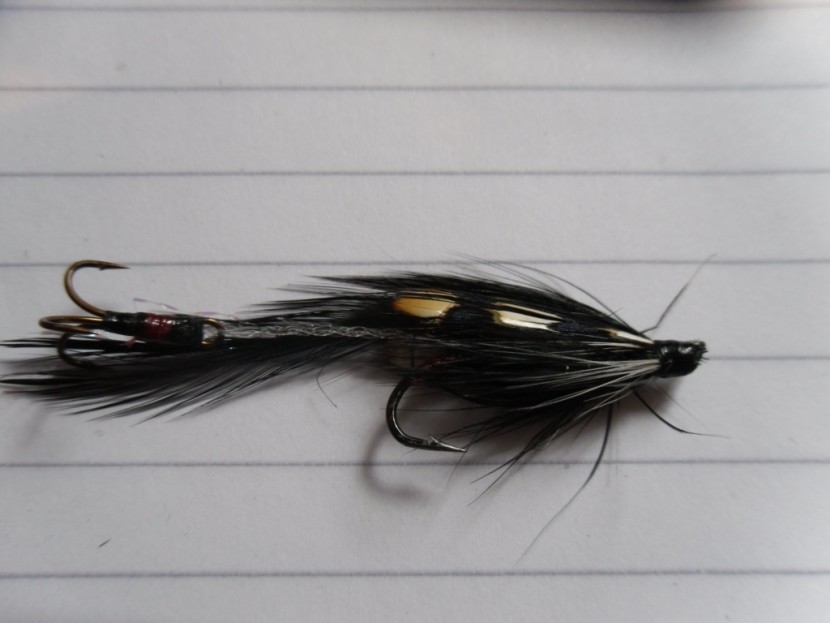 Dark Stranger
Dark Stranger 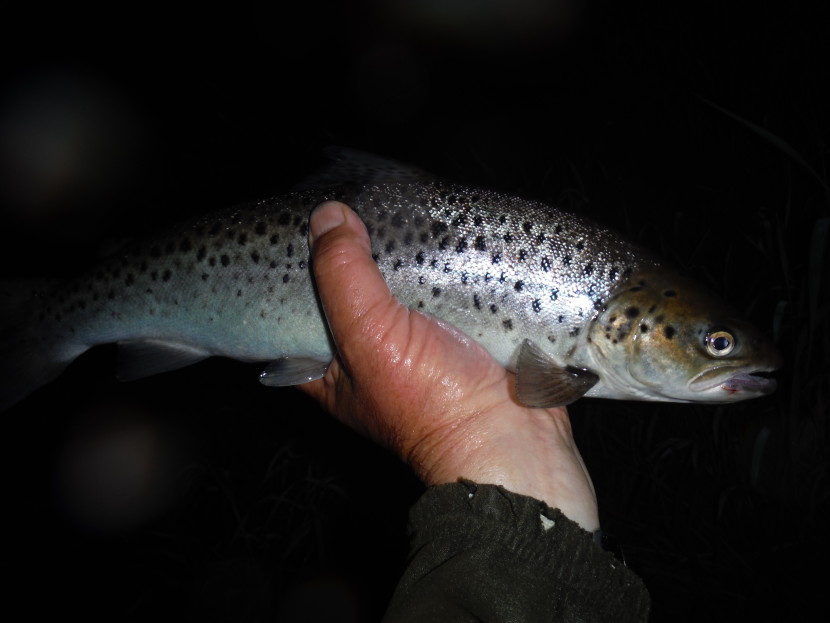 Fresh from the sea
Fresh from the sea Other methods. Steffan guides also for brown trout and grayling and so clearly has a good working knowledge of other types of fishing and other methods. Thus he describes occasions when small sea trout are genuinely feeding on fly hatches in the river, in which case he goes after them with a 9 foot 4 weight rod and a dry fly in the day time. He also mentions small rising sea trout taken with a sedge pattern at dusk. The Duo or New Zealand style method also has a place in his armoury as well as fishing nymphs under an indicator such as a Thingamobobber, or indeed fishing Czech style or with a French leader on a 10 foot 3 weight rod. I don’t have much experience of day time fishing on sea trout rivers, but Lyn Davies is one who will confirm that all these methods will sometimes take sewin if they are present. Finally, as an alternative to day time spinning in the case of a falling flood, he suggests fishing big salmon flies such as Sunrays, Monkeys or Collie Dogs in sizes from 2 to 6 inches.
Spinning. Probably more sewin are taken by those daytime spinning a falling flood than any other method. (Steffan mentions that he does not know anybody who spins at night with the single exception of a chap who throws a wooden surface lure from a fixed spool outfit in darkness). On spinning, Steffan describes the possibilities of Rapalas of different sizes according to the turbidity of the water fished downstream, and the alternative method of a Mepps spoon cast upstream and reeled back quickly. He likes a single large hook on the tail of a Rapala. There is also some discussion of the comparative merits of braided and nylon lines. He doesn’t mention the upstream Quill Minnow which used to be so popular.
.jpg?w=830) Lyn's Secret Weapon (2)
Lyn's Secret Weapon (2) 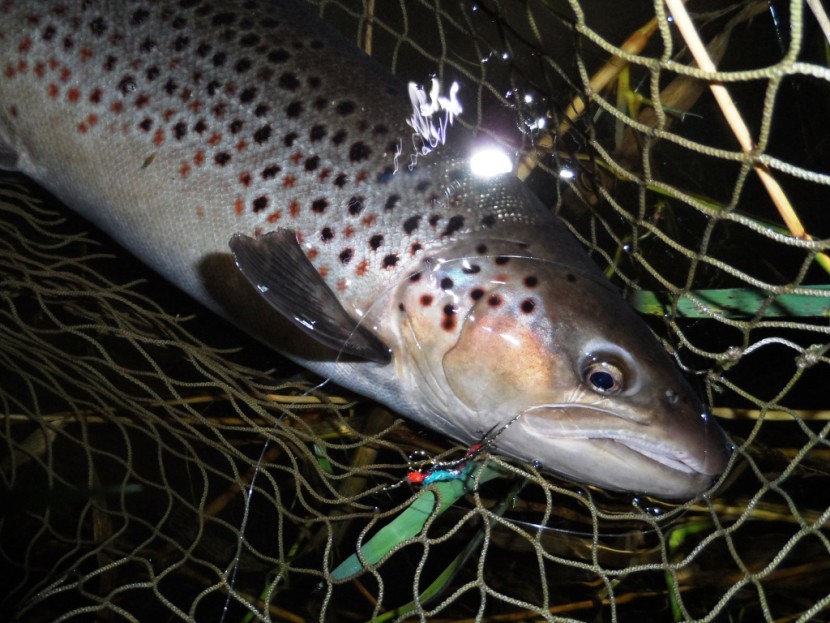 One on Lyn's Secret Weapon
One on Lyn's Secret Weapon 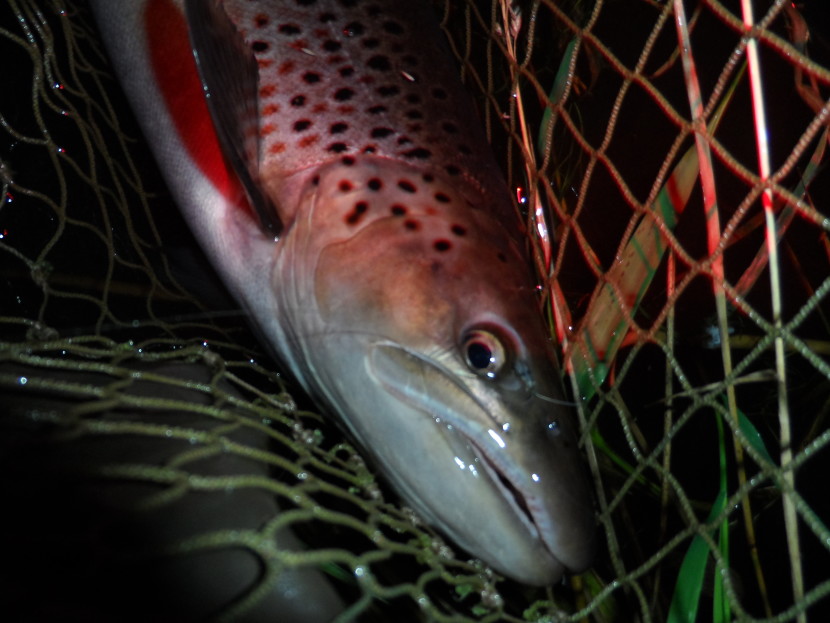 Red torch to keep your night vision
Red torch to keep your night vision Worming. This method is not so much in vogue these days, but Steffan could hardly have been brought up where he was without seeing something of the worming craft and learning how very skilled a method it is. He describes heavy worming in high water, something which can be done with the spinning rod, and light worming in low water, which can be achieved with a very light flexible tipped Avon rod of 10 or 11 feet and 4 pounds BS nylon.
Guest writers. As is the fashion these days, Steffan has invited some contributions from some other specialists, especially regarding flies. Martin Jorgenson of Denmark describes some Baltic fishing which seems to give much greater possibilities than the more limited salt water fishing in the UK. He uses a 9 foot 6 weight rod with a tapered leader and 8, 10 and 12 weight salt water flies, sand eel imitations etc, along with Red Tag, Muddlers and Shrimps. The late Moc Morgan contributed a piece on the evolution of Welsh sewin flies: Teifi Terror, Dai Ben, Harry Tom, Huw Nain and Princess Di. John Graham, who is surely a Welsh national treasure, wrote about the Badger Lure, Alexandra, Black Ghost and his famous Jambo Surface Lure. David Pilkington from the Arundel Arms on the Tamar contributed some small, rather traditional Bumbles and Spiders used for West Country peal. Stjani Ben of Iceland contributed some long-winged white single hooked flies. Claudio Martin and Pepe Borzi, both of Argentina, contributed some mostly introduced flies, including Girdle Bug, Bomber and Green Butt. Tom O’Shea of Iceland turns our thoughts for the first time in this book to traditional lough-style fishing by boat for white trout with flies like Claret Bumble, Connemara Black, Green Peter, Sooty Olive and Watson’s Fancy. Finally Steffan Jones introduces a modest list of his own, including Black and Silver Stinger, Towy Special and various Waddingtons.
I think you owe it to yourself to read this one if you are interested in sea trout, particularly Welsh sea trout. We are struggling a bit regarding sea trout numbers in this area at the moment, but that could change. It is available from Coch y Bonddu Books.
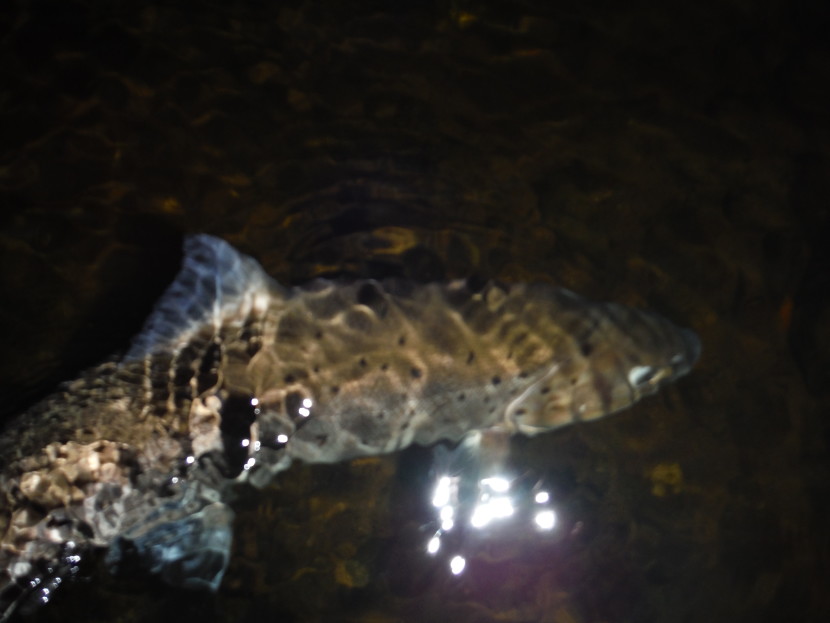 Sewin goes back
Sewin goes back 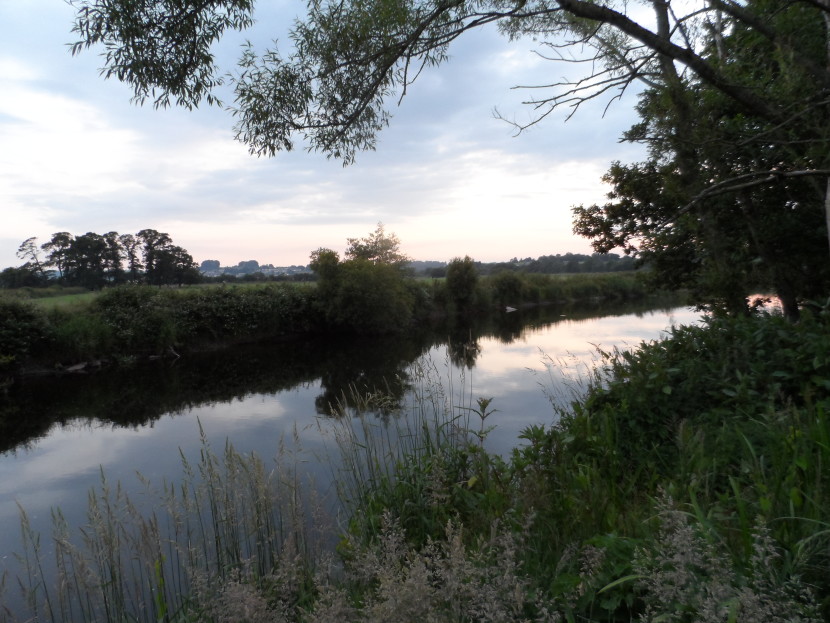 Late evening and quiet water on the Towy
Late evening and quiet water on the Towy 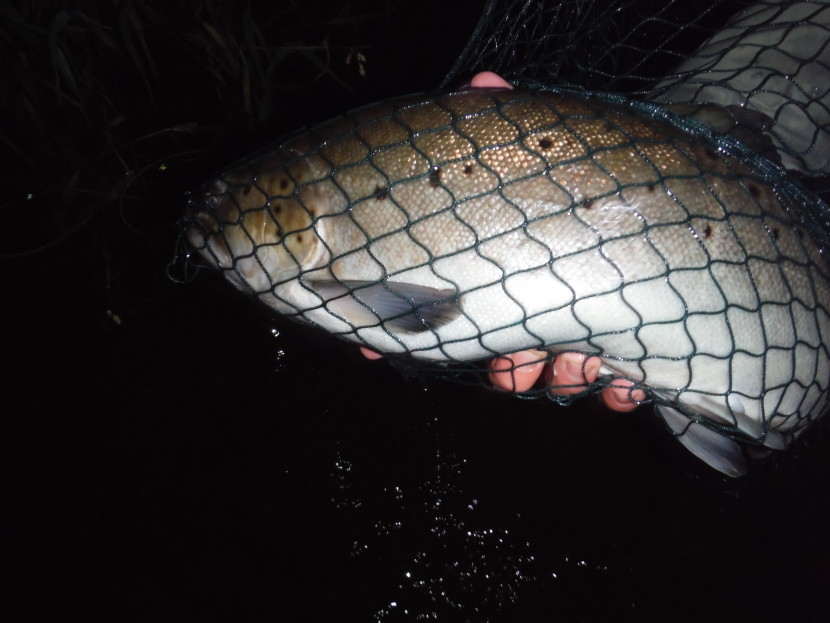 Towy 6 pounder
Towy 6 pounder Will we see the Wye the colour of pea-soup again this summer? Trevor Hyde from Ross Angling Club is our local phosphates monitor for the lower/middle river. At least Trevor is the one who volunteered for it, as he often tends to do (he is also a River Fly Partnership monitor for the River Leadon). The results at Ross tend to confirm the arguments of the Wye Salmon Association, Wye and Usk Foundation and others. The permitted phosphate level for a natural water course is 0.03 parts per million. Trevor has taken 34 water samples since 29 July last year, 85.3% of which have exceeded the maximum permitted level, usually by 4 or 5 times, in one case by 10 times. There is some sign that Welsh authorities are at least beginning to acknowledge that we have a problem – see the WUF newsletter dated 18th March.
Friends and acquaintances tell me I am well-known, or perhaps notorious is a better word, for holding strong views on various subjects. With this in mind, earlier this month I really thought I should form an opinion about the furore between Windsor and Los Angeles concerning the Duke and Duchess of Sussex. This seemed to be engaging so many people around me that even I had started to take notice. Accordingly I got myself ready for the much publicised Oprah Winfrey interview, sitting in front of the television in a comfortable chair with a pad and pencil on one arm and a glass of whisky balanced on the other. I was now ready to listen to the arguments and form my opinion. I remember hearing Meghan the duchess telling Oprah the chat show hostess how much she had suffered, and then hearing Oprah replying sympathetically and encouragingly while probing for more. Empathy was clearly the watchword of the moment. The garden background looked very nice. Oprah’s hair was a work of art. And I remember thinking to myself, who could be better qualified than a millionairess and a billionairess sitting in a pretty garden to discuss and explain the nature of suffering and victimhood for us? And then, perhaps it was the warm room, perhaps it was the whisky, I am afraid I fell asleep, waking up only after the interview was over. So to this day I don’t know what it is/was all about. Or much care.
Congratulations to the town of Usk! It seems that a “panel of experts” has decided that Usk in Monmouthshire is the best place to live in Wales. I don’t know how you get to be an expert in such matters, but I am sure they are right about the town. I look forward to being able to celebrate this triumph with the jovial citizens of Usk, perhaps in Sweets Tackle Shop, but definitely in the King’s Head. Meanwhile it seems that 12th April is now likely to be the critical day for most of us. Like grouse shooting, it may be the “glorious twelfth.” I hope you manage to go fishing in Wales and tight lines if you do!
Oliver Burch